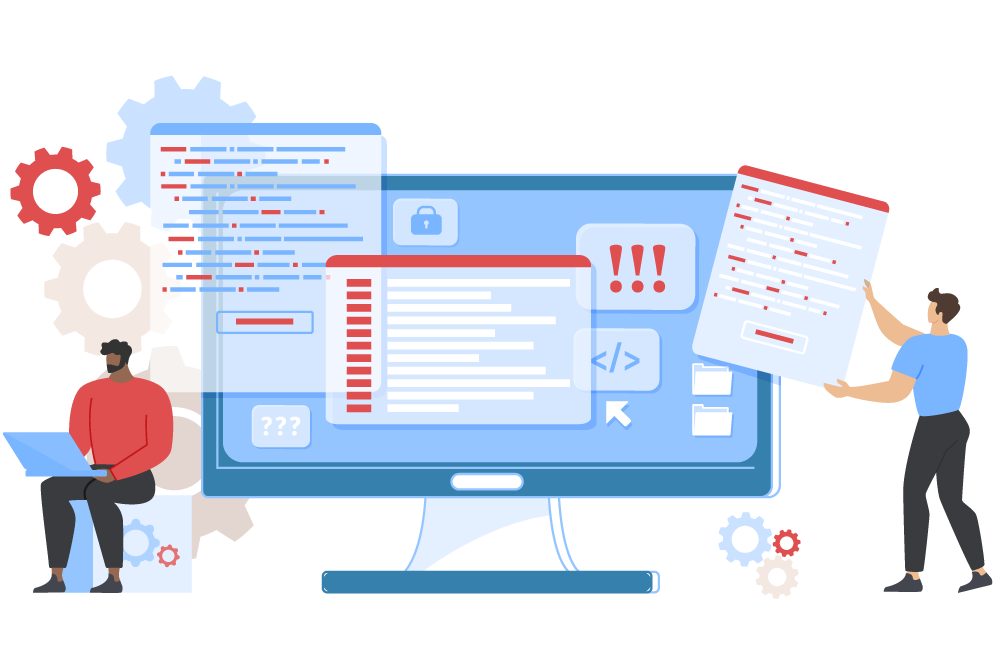Recommended Suggestions For Deciding On Low-Code Platform Sites
Recommended Suggestions For Deciding On Low-Code Platform Sites
Blog Article
Benefits Of Low-Code Development In Terms Of Speed
Visual Development Environment:
Drag-and-Drop Interfaces: Low-code platforms provide visual tools for designing applications. Drag-and-drop components let developers quickly create applications without writing lengthy code.
Pre-built Templates and Components A number of low-code platforms include already-built templates and components which allow developers to rapidly prototype and build applications without the need to begin from starting from scratch.
Reduced Coding requirements:
Automated Coding Generation: Low code platforms automatically generate code in accordance with the visual model created by the developers. This reduces the need to code manually and speeds up the development process.
Reusable Parts Developers will have the ability to reuse reusable components across their projects, thereby reducing the time required for writing and testing code.
Collaboration is streamlined:
Low-code development platforms are often equipped with tools such as deployment, version control, and testing. This allows for seamless collaboration between teams.
Citizen development: Through the use of simple interfaces and decreasing bottlenecks, which are usually caused by the limited availability of developers, business users as well as non-developers can help in the development of applications.
Rapid Iteration and Prototyping
Rapid prototyping: Developers are able to quickly build prototypes that can be used to test ideas and gather feedback, leading to faster iteration cycles.
Easy modifications. The visual nature low-code development provides makes it easy to upgrade and modify applications. This accelerates the process of improving and refining applications based on user feedback.
Pre-built Integrations:
API Integrations: Platforms that are low-code often have pre-built connectors for popular services and APIs making it easier to integrate external systems.
Data Integration: The built-in tools facilitate the process of connecting to databases and other sources, accelerating development.
Deployment and Scaling:
One-Click deployment: Many platforms using low-code provide an option to deploy applications, which can reduce the time and effort.
Cloud-Based Solutions: Cloud-based, low-code platforms can handle scaling and infrastructure management, allowing developers to focus on the application's logic and function instead of the logistics of deployment.
The overall speed of low-code app development lies in its ability simplify and automate various aspects of the application development. This allows quicker delivery of applications and faster adaption to changing requirements. Follow the top read full article for site recommendations including app modernisation, app platforms, cloud software applications, azure sql databases, ms azure sql, application development platforms, lowcode no code, develop web application, cross platform app dev, application modernisation and more.
Benefits Of Low-Code Application Development In Terms Of Governance And Security
Low-code applications offer a number of advantages when it comes to governance and security. Both are crucial for making sure that applications remain in compliance, safe and well-managed throughout their lifecycle. Here are some of the most important benefits:
Unified Manage Console: Lowcode platforms typically have a management console which allows administrators to oversee and manage applications.
Role-Based Access Control RBAC: These platforms have robust role-based controls that allow administrators to establish access policies. This allows only authorized users to alter or access specific areas of the program.
Compliance and Regulatory Conformity:
Built-In Compliance Features: Many low-code platforms are designed to be compliant with the industry standards and regulations (e.g. GDPR, HIPAA). They offer frameworks and tools to ensure that applications comply with requirements.
Audit Trails and Logging : Audit trails, comprehensive logging, and logs are often integrated into businesses which allows them to monitor changes and monitor access. They also can ensure compliance of external and internal laws.
Increased Security Measures:
Data Encryption : Low-code platforms typically provide built-in encryption of data at rest and during transit. This guarantees that sensitive data is protected.
Security Certifications Many low-code vendors have security certifications (e.g. ISO 27001, SOC 2 ) that demonstrate compliance with high security standards. This provides additional assurance for the customers.
Automated security updates:
Regularly scheduled updates and patches: Low-code platforms typically handle regular security updates and patches automatically, making sure applications are protected against the latest threats without requiring developer intervention manually.
Security Monitoring: Continuous security monitoring tools are integrated to give real-time alerts as well as information about potential security concerns.
Data Governance
Data Access Policies These platforms allow organizations to determine and implement their data access policies, ensuring only authorized users are able to access the data and that it's correctly used.
Data Masking, Anonymization and Anonymization Tools: These programs help safeguard sensitive personal data and are particularly helpful in test environments.
Consistent Management of the lifecycle of an application
Pipelines for deployment and development Low-code platforms provide integrated pipelines for development and deployment, which include security checks. These ensure that security is maintained throughout the entire lifecycle of the application.
Version Control: The integrated version control allows for the management of changes and ensures that any changes to the application will be identified and changed if necessary to ensure the integrity of the application.
User Authentication:
Single Sign-On: Support for SSO and other advanced authentication methods simplifies managing users and increases security.
Multi-Factor Authentication - Many platforms support multi-factor Authentication, which adds an extra layer of security when accessing apps.
Monitoring of Policy Enforcement:
Low-code platforms are often pre-defined with policy templates to assist companies in implementing governance and security policies quickly.
Compliance Monitoring Tool: These instruments offer continuous monitoring, reporting and analysis of compliance status. It is simpler to detect potential problems and take appropriate action.
Integration with Existing Security Infrastructure
Seamless Integration: Platforms with low-code are built to integrate seamlessly with existing tools and infrastructure, such as SIEM (Security Information and Event Management solutions) and firewalls.
API Security: Built in API security features protect the data of API users, ensure integrity of applications and safe integrations.
Training and best practices:
Numerous platforms provide guides and best practice for secure application development. They help non-developers adhere to security standards.
Some low-code vendors offer security training to help users learn how to develop and maintain secure applications.
The security and governance features of low-code applications ensure that they are built and managed in a safe and secure way. These platforms offer all the tools and frameworks needed to protect sensitive data and enforce policies while maintaining the regulatory compliance. Check out the most popular my latest blog post about Enterprise application development with Low-code Platform for website examples including develop mobile application, cross platform app development, rapid application design, mobile development platforms, rad application development, application development platforms, develop cross platform mobile app, low code development platforms, application modernisation, build a docker container and more.
The Advantages Of Low-Code Development For The Development Of Applications, In Terms Of Limitations And Customization
Low-code application design is an equilibrative, flexible method that addresses the limitations of the system and allows for customization. The main advantages are: the limitations
Removing Complexity Barriers
Simple Development : Low-code platform reduces complexity by providing components and templates that have been pre-built, which allows for faster development and deployment.
Guided Workflows Many platforms have wizards and workflows to guide developers through complicated processes. This reduces the risk of making mistakes, while ensuring uniformity.
Solutions to scale:
Scalability is built into: Low-code platforms often include features that enable an architecture that is scalable. Applications can handle increasing demands with little changes.
Performance Monitoring: The integrated tools for monitoring performance and optimization can ensure that applications are efficient when they grow.
Security and Compliance
Integrated Security Features: Low-code systems have security features built-in like encryption, role-based access control and automated checks for compliance to address security issues that are common.
Platforms frequently update their security and compliance procedures to ensure that their applications are secure against threats that change.
Capabilities to Customize:
Extensibility:
Low-code platforms can often be able to integrate custom-written code such as JavaScript or Python that allow developers to enhance their capabilities beyond the standard.
Customized plugins and modules: Developers can create custom plugins or modules to add specific functionalities tailored to unique business requirements.
APIs and Integration:
API Support - The extensive API support permits seamless integration with external systems and services and allows for complete modification.
Third-Party Applications: Lowcode platforms are often built with connectors for third-party apps, making it simpler to integrate them and customize the application.
Flexible UX/UI:
Customizable user interfaces for developers: Developers can modify and design user interfaces so that they satisfy specific branding requirements and requirements for usability, resulting in the user with a customized experience.
Responsive Design: The built-in capabilities of responsive design make sure that applications are able to be tailored to various screens and devices.
Business Logic Customization
Visual Workflow Builders: These tools allow developers build complex processes with minimal or no programming. They can create business processes and workflows visually.
Platforms offer conditional logic to adapt to certain business requirements or scenarios.
Data Management:
Custom Data Models Developers can choose to design custom data models for specific applications, adjusting data handling to the specific requirements of business.
Advanced Data processing: Integration and advanced data handling tools allow for the customisation of the data analysis process and usage within the application.
Balance Customization and Limitations
Frameworks and Standards:
Low-code platforms comply with the industry standard and best practices. This helps maintain the highest quality and security of applications.
Governance Frameworks. Inbuilt frameworks for governance make sure that any modifications do not compromise the security, compliance or integrity of the application.
Feedback and iterative development:
Rapid Prototyping. The ability to speedily prototyping and testing modifications allows developers to iterate the application according to the feedback of users. This allows them to improve the app in order to better meet the needs of users.
Low-code platforms allow for continuous improvement, allowing for ongoing customization and enhancing as requirements for business change.
User Empowerment
Giving Citizen Developers the tools they need: Low-code platforms boost the number of contributors capable of enhancing and customizing applications by permitting them to create custom simple user interfaces.
Training and Support Many platforms offer comprehensive instruction and resources that assist users to customize their applications, while not impacting the stability or performance of the application.
Low-code development is an effective framework that allows for plenty of customisation while addressing any limitations. This allows businesses to develop and maintain applications that are efficient, adapted for their specific needs and meet the highest standards of security, quality, and scaling.